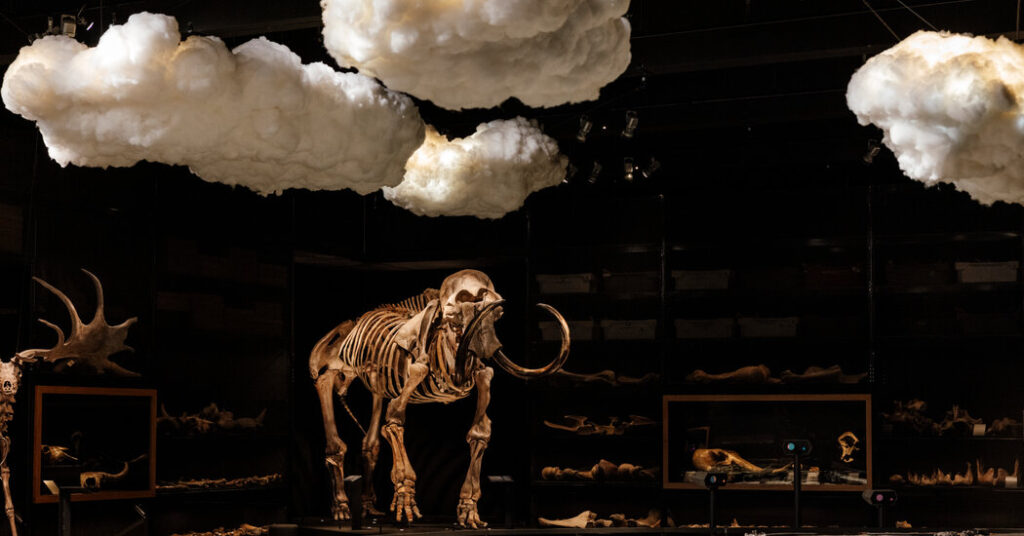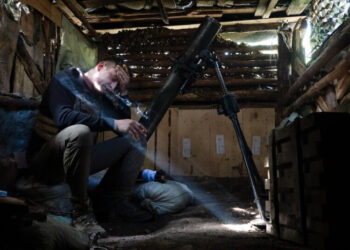After scouring a beach in the harbor all morning in Rotterdam, the Netherlands, a retired Dutch engineer, Cock van den Berg, had finally found something interesting: a polished black stone about the size of an acorn with two punctures, like finger holes in a bowling ball.
He held it out in the palm of his hand to show Dick Mol, an expert on ice age fossils.
“What do you think?” he asked. “Is it a mammoth tooth?”
Mol examined it for about 30 seconds and decided it was not. It was a molar from a woolly rhinoceros, he said.
“It’s from a forest rhino,” he added, dating to “the time that hippos and straight-tusked elephants were living here,” about 126,000 to 116,000 years ago.
Van den Berg is what Dutch scientists like to call a “citizen paleontologist,” one of a cadre of enthusiastic scavengers who come to this 8-square-mile stretch of white sand beach dotted with wind turbine, to hunt for ice age fossils.
They arrive during the day, or show up in the evening after low tide with flashlights, to check the wet sand as the sea recedes.
The port of Rotterdam, the largest harbor in Europe, might not be the kind of place one would expect to find clues to the Pleistocene Era. But as it happens, the human-made beaches that surround the harbor are considered key locations for finding remains of woolly mammoths, woolly rhinos and other giant creatures that roamed here many thousands to millions of years ago.
The beach where van den Berg was hunting, called Maasvlakte 2, is a particularly popular destination for fossil seekers, because it was built using sediments dredged from the North Sea floor. From about 2.5 million to 11,700 years ago, the area that is now underwater was a mammoth steppe of grassy hills, flatlands, valleys and streams on a prehistoric landmass called Doggerland.
“You could walk from here to London,” explained Mol, standing beneath a slowly whooshing turbine. “But be careful, because there are hyenas and saber-tooth cats.”
Some 30 or 40 species of impressively large creatures, known as megafauna, lived on the steppe, including giant horses, giant bison and even beavers that could grow to 8 feet tall.
Today, the beach contains their bones, dating back tens of thousands to millions of years.
Under Dutch law, beach combers who find fossils on Maasvlakte 2 are not required to report or submit them. They can take their finds home if they like, but they are encouraged to promote scientific research by voluntarily registering them with Naturalis Biodiversity Center, a national natural history museum and research center in the city of Leiden.
Using a website built by the port of Rotterdam authority and managed by Naturalis, amateur paleontologists can submit a photo and the GPS location of the find so that experts can help them identify it.
“In other countries, like Germany, fossils or anything related to paleontology are protected by the state, but that’s not the case in the Netherlands,” explained Isaak Eijkelboom, a Ph.D. student in paleontology at Naturalis who studies fossils found at Maasvlakte 2 and other locations.
But since trophy hunters don’t have to worry about losing their finds, he thinks they’re more likely to share their discoveries with the museum and collaborate with scientists.
“It allows us to practice citizen science,” Eijkelboom said.
For more than a decade, Naturalis has been using volunteers to gather information for its fossil database, which now lists more than 23,000 finds, he said.
“This is only possible because it’s so open, and so free,” Eijkelboom said. “In other places, when people find fossils, they end up in their closets and the knowledge is hidden away.”
Van den Berg, who discovered the rhinoceros molar, said he was excited to share it with Naturalis. A few years ago, he found a jaw part from a macaque monkey at Maasvlakte 2 and donated it to the National History Museum in Rotterdam. The rare specimen, which scientists dated to 125,000 years ago, was described in three scientific papers, Mol said.
This time, van den Berg said, he would share information about his discovery with scientists but keep the tooth for himself.
Mol joked that the “biggest mistake of van den Berg’s life” was donating the monkey jaw to the museum and not to Mol’s “Mammoth Lab” at Historyland, a museum and theme park that he helped establish in the town of Hellevoetsluis, about a 15-minute drive from the beach.
There, Mol, a retired airport customs official, has his own impressive collection of 55,000 ice age fossils. An autodidact who never attended university, Mol is nonetheless widely recognized as an international expert; in 2000, he was knighted in the Netherlands for his significant contributions to paleontology, and he was featured in Discovery Channel documentaries such as “Raising the Mammoth” and “Land of the Mammoth.”
These days, he uses his fossils to teach school children about the ice age, and helps conceive of museum displays. The latest is life-size replica of a southern mammoth, about 13 feet tall, a non-woolly species that migrated from Africa to Doggerland and lived for 1.5 million years in what is now Northern Europe.
Mol explained that the southern mammoth was an evolutionary predecessor of the steppe mammoth and eventually the woolly mammoth, the ice-age icon. In Doggerland, they began to die out tens of thousands years ago, Mol said, as the climate there became inhospitable. Then, about 11,700 years ago, he added, the average annual temperature increased substantially, causing glaciers to melt and rising seas to inundate the mammoth steppe.
Fossils of Pleistocene creatures from this era remained submerged, untouched, for eight millenniums. Then, in the 1950s, Dutch fishers started trawling the North Sea floor for bottom-feeding fish, like haddock and sole, and kept finding giant fossilized bones in their nets.
Twenty years later, after an extension of the Rotterdam port, beach combers found lots of fossils from the early Holocene era, the period after the Pleistocene, from about 11,700 years ago until about 9,000 years ago.
One local retiree who liked to stroll on the beach, Niek Kerkhoff, amassed thousands of Holocene fossils that he bequeathed to Naturalis upon his death in 1994. The Kerkhoff Collection represents a small part of the 30,000 to 40,000 specimens that make up Natural’s collection, one of the largest troves of ice age mammals anywhere, according to David Douw, a collection manager at the museum.
Without citizen scientists like Kerkhoff, van der Berg and Mol, said Frank Wesselink, a senior researcher of paleontology at Naturalis, the museum would not have the capacity to collect so many specimens.
By collaborating with the public, he added, “both you learn, and we learn.”
On Maasvlakte 2, Piet Heezen and his three children had driven about an hour from the city of Breda to learn. One of his daughters Tatum, 7, collected a large bag of pretty seashells, and his son, Mees, 4, played in the sand while Charlie Heezen, 8, showed Eijkelboom a small black triangular object she’d found.
He gave it a closer look and said it was likely a 10,000-year-old shark’s tooth.
Piet Heezen was impressed. “Now that we know what we’re finding, we’ll come next time with a guide,” he said.
Other seaside rovers were striking out. Heike Kölsch, from Bonn, Germany, and her husband and two children, ages 12 and 15, found only an attractive piece of fossilized driftwood.
But she didn’t mind. “We’ve been doing this for 20 years,” she said. “Once we found an ice age horse tooth and another time a deer tooth — but not this time.”
In spite of a steady stream of beachcombers, Eijkelboom said there will still be plenty more fossils to find for a long time to come.
“In general, in paleontology, a lot of people say we’ve only discovered the tip of the iceberg,” he said. Rising sea levels will require continued fortifications of the Dutch coastline, using North Sea sand deposits for quite some time to come, he added.
Although it is unfortunate that such action is needed to prevent humans from going extinct like the mammoth, he said, “at least there will be more and more beaches where we can hunt for ice age fossils.”
The post A Day at the Beach Hunting Mammoths appeared first on New York Times.




